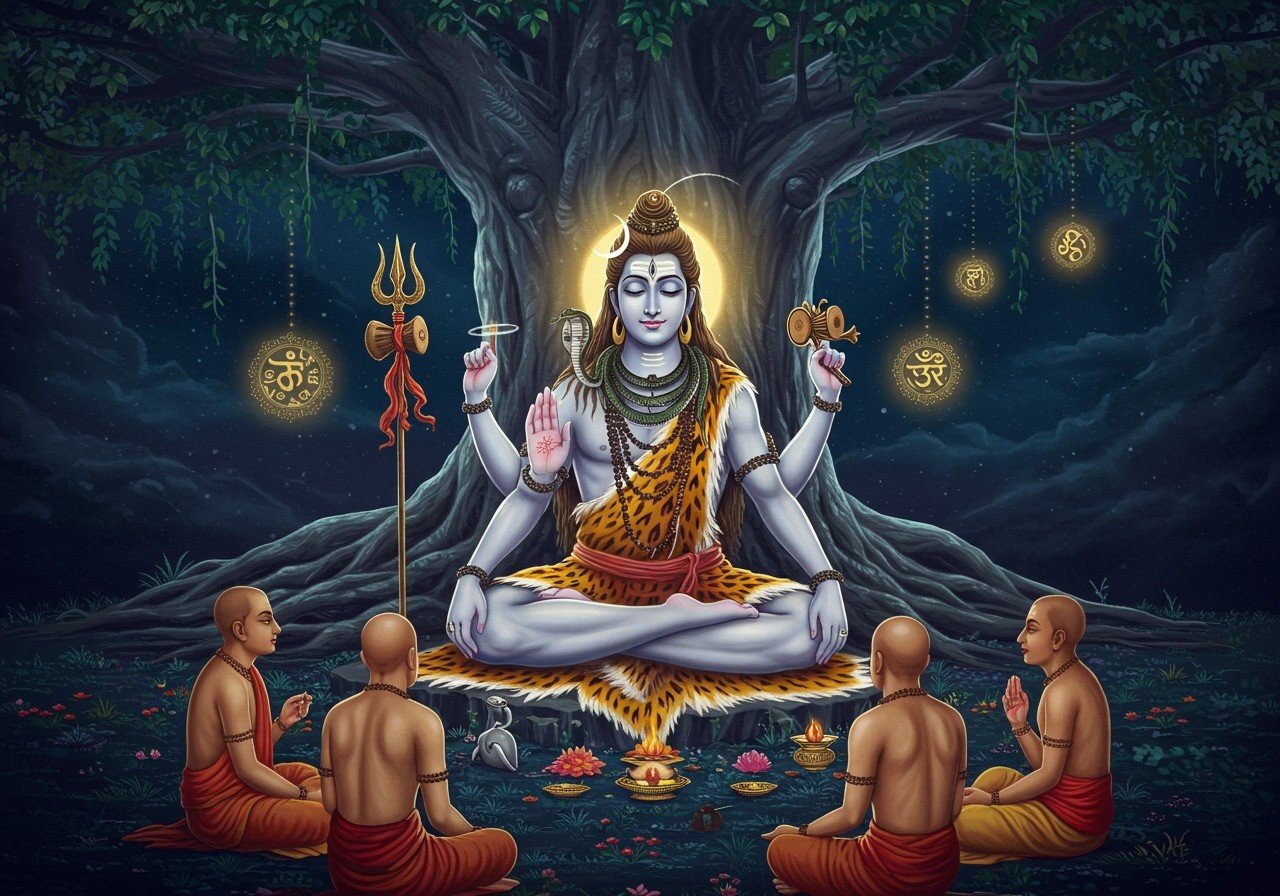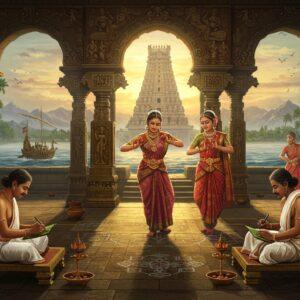
Exploring the teachings of the Dakshinamurti Upanishad and Samhita offers us a glimpse into the profound wisdom of Hindu philosophy. These ancient texts hold a revered place in the Vedantic tradition, connecting us to timeless truths. For Indians who value tradition and spirituality, understanding these teachings can deeply enrich daily life and spiritual practice.
Dakshinamurti Upanishad: A Journey into Knowledge
The Dakshinamurti Upanishad, a jewel among the minor Upanishads, delves into the nature of Brahman, the ultimate reality, and the transformative power of knowledge in attaining moksha, liberation. Lord Dakshinamurthy, revered as the ultimate guru, embodies this liberating knowledge. The Upanishad emphasizes self-realization and the direct experience of truth, known as aparoksha anubhuti, a concept deeply rooted in Indian spiritual thought.
Core Teachings of the Dakshinamurti Upanishad
The Dakshinamurti Upanishad illuminates the concept of Advaita, non-duality. This profound philosophy teaches the oneness of everything, dissolving the perceived separation between the individual self (Atman) and the ultimate reality (Brahman). The Upanishad guides us to transcend the illusion of duality, encouraging a life of unity and harmony, a principle deeply embedded in Indian culture. It emphasizes meditation and contemplation as vital practices for understanding our true nature. By turning our gaze inward, we move closer to self-realization and inner peace. The Upanishad encourages detachment from material desires, shifting our focus towards spiritual growth and understanding.
Dakshinamurti Samhita: Embracing Ritual and Devotion
The Dakshinamurti Samhita, a cornerstone of the Shaiva tradition, focuses on the rituals and mantras dedicated to Lord Dakshinamurti. These practices, passed down through generations, are designed to deepen our spiritual knowledge and connection with the divine. The Samhita stresses the invaluable role of a guru in guiding us on our spiritual journey. It emphasizes devotion and surrender to the divine as transformative forces. The text teaches that true devotion, or bhakti, purifies the soul, empowering individuals to navigate their spiritual path with discipline and unwavering focus. This deep reverence for the guru and devotion to the divine is integral to Indian spirituality.
The Dakshinamurthy Stotram: A Hymn of Praise and Wisdom
Composed by Adi Shankaracharya, the Dakshinamurthy Stotram is a sacred hymn that extols Lord Dakshinamurthy as the embodiment of wisdom and the ultimate teacher. Each verse encapsulates the essence of Advaita Vedanta, emphasizing the unity of Atman and Brahman, a core principle of Hindu philosophy. This Stotram serves as a powerful tool for meditation, promoting wisdom and mental clarity.
Chanting the Dakshinamurthy Stotram offers profound benefits. It dispels ignorance and confusion, nurturing spiritual growth and self-realization. By exploring their inner selves through this practice, devotees discover inner peace and a sense of purpose. Reciting the Stotram is also believed to help overcome obstacles and enhance overall well-being, aligning with the holistic approach of Indian traditions.
Meaning:
- Guru Tattva: The stotram reveres Sri Dakshinamurthy as the ultimate guide, highlighting the crucial role of the Guru in dispelling the darkness of ignorance and leading disciples away from Maya (illusion), a concept deeply ingrained in Indian spirituality.
- Advaita Vedanta: Each verse encapsulates the core principles of Advaita Vedanta, revealing the non-dual nature of reality and the beautiful unity of the individual self (Atman) with the ultimate reality (Brahman). This non-dualistic perspective is fundamental to many Indian philosophical schools.
- Self-Realization: The stotram emphasizes that the ultimate Truth is Brahman, and the Guru acts as a torchbearer illuminating this Truth. It guides individuals toward self-awareness, cultivates inner peace, and encourages liberation from worldly attachments. This journey of self-discovery is central to many Indian spiritual traditions.
- Dakshina means south: Lord Shiva, in his form as Dakshinamurthy, sits under the sacred Banyan tree, facing South as he imparts his wisdom. This directional symbolism is significant in Hindu traditions.
Benefits:
- Removes Ignorance and Confusion: By invoking Lord Dakshinamurthy’s blessings, devotees can dispel the clouds of ignorance, confusion, and misconceptions. This clarity fosters mental sharpness and a clearer perspective on life’s journey, a benefit highly valued in Indian culture.
- Supports Spiritual Growth and Enlightenment: The Dakshinamurthy Stotram nurtures spiritual growth by inspiring devotion, encouraging self-discipline, and deepening one’s connection with the divine. It guides seekers on the path to enlightenment, a central aspiration in many Indian spiritual paths.
- Promotes Self-Realization and Inner Peace: Chanting the Dakshinamurthy Mantra encourages profound self-reflection, inviting devotees to explore their inner selves and understand their true nature. This leads to a deep sense of peace, purpose, and fulfillment, qualities highly cherished in Indian traditions.
- Attainment of Siddhis: Regular recitation and meditation on this Stotram can help achieve a state of universal consciousness, potentially leading to the attainment of divine powers (Siddhis), a concept often explored in ancient Indian texts.
- Overcoming Obstacles: Reciting the Dakshinamurthy Stotram is believed to mitigate the negative effects of malefic planets and pave the way for salvation, a belief deeply rooted in Indian astrology and spirituality.
- Overall well-being: The recitation of the Stotram is believed to promote holistic well-being, including health, wealth, and the fulfillment of righteous desires, reflecting the interconnectedness of mind, body, and spirit in Indian thought.
Poojn.in: Supporting Your Spiritual Journey
At poojn.in (https://www.poojn.in), we understand the deep significance of these spiritual practices. We offer a curated selection of authentic puja items to support your connection with Dakshinamurthy and enhance your spiritual practice. You can find:
- Exquisite brass (https://www.poojn.in/product/24337/pure-brass-lord-kubera-murti-pure-brass-lord-kuber-antique-idol-the-god-of-wealth-prosperity-5-inch) and copper idols of Lord Dakshinamurthy, crafted with reverence and attention to detail.
- Pure copper water vessels (kalash) (https://www.poojn.in) for ritual use, ensuring purity and sanctity in your practices.
- Traditional bell-metal items (https://www.poojn.in) for puja ceremonies, adding a touch of tradition and authenticity.
- Sacred thread (janeu) (https://www.poojn.in) made from pure cotton, symbolizing purity and spiritual connection.
- Copper plates (tamra patra) (https://www.poojn.in) for writing mantras, enhancing the power of your spiritual practice.
- Pure ghee from indigenous cows (https://www.poojn.in) for ritual lamps, illuminating your path with purity and devotion.
- Cotton wicks (https://www.poojn.in) for ritual deepam, symbolizing the flame of knowledge and wisdom.
All our items are carefully verified for purity and ritual suitability by our panel of learned priests. You can conveniently order these items online through our website or contact us directly:
Phone: 03369029784
WhatsApp: 9476142738
We offer pan-India delivery with secure packaging to maintain the sanctity of all items. Each product comes with clear instructions for proper ritual use. As India’s leading Dashakarma bhandar, we are committed to providing you with genuine products that meet traditional specifications.
Embracing the Wisdom: A Path to Oneness
The teachings of the Dakshinamurti Upanishad and Samhita offer a profound path towards understanding the essence of oneness and recognizing the divine presence within all of creation. As you delve into these texts, allow their wisdom to illuminate your journey towards self-realization and inner peace. Embrace meditation, cultivate devotion, and seek the guidance of a guru to deepen your spiritual connection. By reflecting on these teachings, you honor the rich tapestry of Indian traditions and open your heart to profound spiritual growth. Whether through chanting the Dakshinamurthy Stotram or studying the sacred texts, these practices invite you to explore the unity of Atman and Brahman, ultimately leading to a life of harmony, purpose, and well-being, enriched by the timeless wisdom of Dakshinamurti.
You can further deepen your understanding of devotion and epic narratives by exploring resources like the Ramcharitmanas: A Deep Dive into Devotion and Epic Narrative. The Hanuman Chalisa: Meaning, Benefits, and Recitation offers another powerful way to connect with the divine and experience the benefits of chanting.


